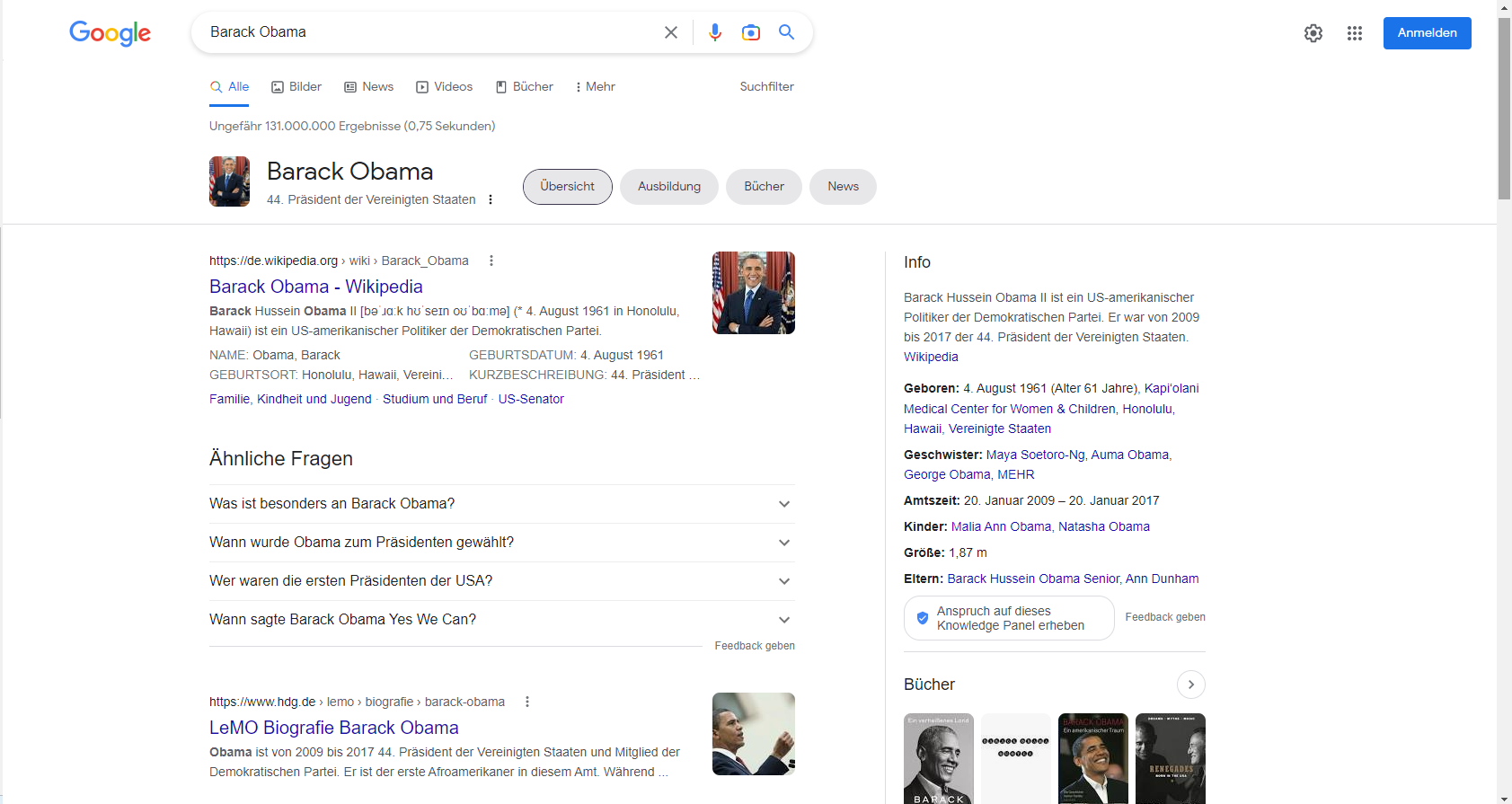All about entities in SEO
- The term entity is derived from the Latin word "ens", which translated into English means "thing".
- Originally, the term comes from philosophy and deals with the central question of the nature and essence of reality
- After the introduction of the Google Knowledge Graph in 2012 and the Hummbingbird Update in 2013, keyword-based search has evolved into semantic search
- This means that search engines now try to understand the meaning of the search query in order to provide more relevant results
- For you, this means that the context of your content is in the foreground. Treat topics holistically and structure & link them in a meaningful way.
In this article we cover the following topics:
Are you looking for an SEO partner, SEO advice or a holistic and, above all, up-to-date SEO strategy to get more traffic today and tomorrow? Then you've come to the right place. Our agency stands for sustainable, individual and transparent search engine optimisation. Together we can take your company or project to the next level. Feel free to contact us by email, phone or Whatsapp.

The origin of the term entity
The concept of entities originally comes from philosophy and deals with the central question of the nature and essence of reality. An entity is a concept or thing that exists independently of other concepts or things. Examples of entities are numbers, properties and relationships. In the physical world, entities include objects such as tables and chairs, and natural phenomena such as mountains and rivers. In the abstract world, entities include concepts such as justice and freedom. Entities can also be fictional, such as the character of Sherlock Holmes. Entities are everywhere, in computer science, religion, anthropology, physics and also in the spiritual tradition. The debate about entities revolves around the question of whether they exist in objective reality or merely in our imagination.
In this article, we would like to talk specifically about what entities have to do with the online marketing world and search engine optimisation. Have fun reading.
What are entities?
The term entity is derived from the Latin word "ens", which translates into German as "entity". „Ding“ bedeutet.
In computer science, entity refers to an object in which a set of different information is stored. This can be transferred to the context of online marketing. Here, the term entity plays a role especially in search engine optimisation. The entity functions here as a generic term for all the information it contains. This semantic (significant, meaningful) content serves to define the preceding entity.
An entity can include a person, an event, a thing such as a product or other things. It can also be an organisation or a place. Each entity has specific attributes that characterise it and make it unique.
All this information about an entity together forms its identity. Within the framework of SEO measures, therefore, not only texts are optimised in terms of their content and keywords, but also their structure in terms of entities. An important aspect here is that each entity must be assigned a unique identifier (Uniform Resource Identifier or URI) so that the search engines can identify it unambiguously and thus also take contexts into account. This can be a URL, for example, or an arbitrary series of numbers. This improves the quality of the search results and also promotes the position of a website in the search engine ranking.
Entity SEO: from keyword to entity
In the past, search engine optimisation was about placing as many keywords as possible on a page in order to rank higher in the search engine results pages (SERPs).
However, Google's algorithm has evolved over the years and is now able to understand the relationships between different concepts and ideas.
As a result, SEO has also evolved from a focus on keywords to a focus on semantics, i.e. the meaning and significance of content. But what has contributed to this?

Einfluss des Knowledge Graphs & des Hummingbird Updates
In 2012, Google realised that the way people search the internet had changed. People were no longer searching for just a set of keywords, but for related entities. In response, Google introduced its Knowledge Graph, a database of 500 million real-world objects and 3.5 billion facts and relationships between those objects. The Knowledge Graph is the key element for semantic search and acts as a semantic database. Since then, Google has been working on collecting data and extracting entities from the entire web. The Hummingbird update, in 2013, also contributed significantly to the change from keyword-based to semantic SEO. From now on, all semantic content in the form of entities was in the focus of the website evaluation.

The advantage of using entities
A major advantage in using entities is that they are language-independent. This makes entity-based search more efficient, as the search engine can query the content of all languages simultaneously to find the best information.
With the introduction of the Google Knowledge Graph, searching the web for landmarks, celebrities, cities, sports teams, buildings, geographic features, movies, celestial objects, works of art and much more was no longer the same. The first step towards "entity-first indexing" was taken. At Google, the Knowledge Graph is constantly being developed further by adding new entities and refining existing ones.
The goal is to provide users with the most relevant and useful information for their query. As the Google Knowledge Graph continues to grow, it will become an even more valuable resource for users and equally for businesses .
What is an entity type?
An entity type is a data structure that defines the properties, relationships and attributes of a real object. In database design, an entity type is used to represent a table. Each entity type has a unique set of attributes, i.e. information that defines the object. For example, an entity type for a person may contain attributes such as name, age, address and telephone number. It can also define how different entity types relate to each other, for example "friend" or "customer".
In summary:
Entity types describe groups of entities that can be grouped together and clearly defined based on their properties.
Which entity types exist?
Different entity types help search engines like Google to organise information and correctly classify users' search queries. The number of entity types is theoretically infinite. However, Google only recognises a limited number of types when sorting information for the Knowledge Graph.
According to Google, the following are among these types:
Book
BookSeries
EducationalOrganization
Event
GovernmentOrganization
LocalBusiness
Movie
MovieSeries
MusicAlbum
MusicGroup
MusicRecording
Organization
Periodical
Person
Place
SportsTeam
TVEpisode
TVSeries
VideoGame
VideoGameSeries
WebSite
How does Google use entities?
Google uses entities to give meaning and context to information on the internet. It does this by understanding the relationship between different pieces of information and using this knowledge to rank search results. For example, if you search for "Barack Obama", Google understands that you are looking for information about the 44th President of the United States. Google then shows you a knowledge panel, or entity boxes, with the most relevant results. For example, you get an overview with information about his term in office, his family, his biography and further questions that fit the topic. (see screenshot)

Entities not only provide accurate search results, but also help Google make decisions about ads and content. Because Google knows the relationships between different entities, it can serve ads that are more likely to match your interests.
In a nutshell: Entities are a fundamental part of the way Google understands and organises information on the web.
How do search engines recognise entities?
Search engines use a variety of methods to identify entities on the web. One way is to look for common patterns that point to an entity. For example, most entities have a unique URL, and they are often linked to from other websites. Search engines can also use the structure of the web itself to identify entities. For example, Wikipedia pages are usually well-defined entities that are often linked to from other pages about the same entity. Finally, search engines can also use artificial intelligence techniques such as natural language processing (NLP) to identify entities. This involves analysing the content of web pages to look for clues that indicate that the page is about a particular entity.
Realisation in search engine optimisation
For search engine optimisation, the following can be derived from these findings:
Since Google can recognise entities and use them to classify websites or content, the content of a website must in future cover an entire semantic space and should no longer be limited to a small keyword space.
This form of optimisation in turn offers the possibility that Google itself recognises a website as an entity and assigns it certain properties and terms by algorithm. This then allows subpages to rank for terms for which the texts of the page were not primarily optimised. By targeting semantic spaces, the content covers the claims of relevance for a particular search term. The keyword is used as the starting point for this process.
By providing information about entities on your website, you help search engines understand the importance of your content and increase your chances of appearing in relevant search results.
Why are entities important for SEO?
One of the main goals of search engine optimisation is to make a website more visible on search engine results pages (SERPs). To achieve this goal, it is important to understand how search engines work:
In recent years, the focus has shifted from keyword-based search to semantic search. This means that search engines now try to understand the meaning of the search query to provide more relevant results, rather than matching a search query with a list of keywords. Semantic search is enabled by entities, which are concepts or ideas that can be identified and categorised. By understanding the relationships between entities, search engines can provide more relevant and accurate results for search queries.
For example, if you search for "Bill Gates", the search engine does not simply return a list of websites containing the names "Bill" and "Gates". Instead, it tries to understand who Bill Gates is and returns results that relate to him, such as his biography or recent news articles about him.

Entity Optimisation - What you can do with SEO
The goal of search engine optimisation for companies is to promote the association of their own website or brand with certain terms and entities. There are various approaches to this, which we would like to present in more detail below:
Content: Content is and remains the most important factor. It must be relevant and up-to-date. The difference, however, is that you also have to consider the context of your content holistically in order to score in terms of entity SEO. If you want to rank for a certain term, you should examine the entities of your competitors and try to understand how the results relate to each other. Use these findings as a basis for optimisation.
Link building: Don't burden your content with low-quality backlinks. Even if links used to be important for good rankings, today you should think about whether a link makes sense for your readers at all. Today, links are considered to be signs of connections, i.e. entities, and should be placed with care. The goal is to get links from pages that have a strong entity themselves & to set links to such pages.
Semantic data: They are also called structured data and add labels to unclassified information so that they can be considered entities. "SameAs" allows the URL of a reference web page in the source code to be submitted to a search engine, uniquely identifying the item. As a result, the two URLs representing an entity are considered equivalent.
How to get into the Google Knowledge Graph
Google's Knowledge Graph is a database of information about businesses such as books, movies and people that are relevant to the public. Unfortunately, no one really knows what is considered relevant to Google, but if you, your business or your book, are included in the Knowledge Graph, there are some significant benefits.
For example, if someone searches for something related to you or your work, compact information about you will be prominently displayed on the right side of the screen in the SERPs. Since Google learns a lot about the relationships and properties of entities in the Knowledge Graph, inclusion in the Knowledge Graph can also increase your chances of ranking well for related searches.
There are some measures you can take to increase your chances of being included in the Knowledge Graph. For example, making sure your content is consistent will make it easier for Google to crawl and index it. Also, having structured data on your website can give Google more information, which increases the likelihood that you will be included in the Knowledge Graph. Ultimately, however, it's up to Google.
Image sources:
- Glenn Carstens-Peters/unsplash.com
- Solen Feyissa/unsplash.com
- Screenshot
- 123rf.com/profile_marchmeena
About the author: Louisa Anger

Louisa specialises in writing search engine optimised texts and articles in the online marketing field. She researches and writes SEO-optimised content for various companies from different industries. At SEO-Suchhund, Louisa is the person responsible for the topic of SEO content.
